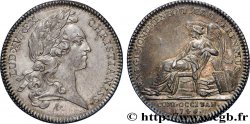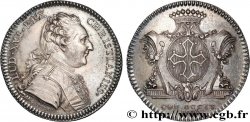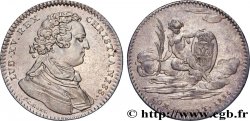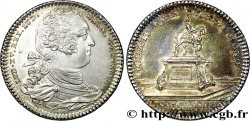fjt_128228 - LANGUEDOC (ÉTATS DE ...) Jeton Ar 30, États de Languedoc - Statue équestre de Louis XIV 1733
недоступный.
Товар уже продан в нашем интернет-магазине
Цена: : 180.00 €
Товар уже продан в нашем интернет-магазине
Цена: : 180.00 €
Тип Jeton Ar 30, États de Languedoc - Statue équestre de Louis XIV
Дата: 1733
Металл: silver
Диаметр: 30,5 mm
Ориентация осей монеты: 6 h.
Вес: 10,15 g.
Редкость: R1
Ссылки в каталоге: :
Лицевая сторона
Аверс: описание: Buste à droite de Louis XV, au-dessous signature JCR en monogramme.
Аверс: перевод: Le roi Louis XV, petit fils de Louis XIV.
Обратная сторона
Реверс: легенда: CRESCIT FAMA CRESCIT HONOS ; À L’EXERGUE : COM. OCCIT. 1733.
Реверс: Описание: Statue équestre de Louis XIV sur son socle et dominant un horizon lointain qui s’étend jusqu’aux premiers contreforts des Cévennes.
Реверс: перевод: Les honneurs qu’on lui rend croissent avec sa gloire/États de Languedoc.
Комментарий
La statue équestre de Louis XIV, érigée en 1718 à Montpellier sur la place du Peyrou, fut longtemps l'objet de la sollicitude des États. Après avoir fait décorer magnifiquement le piédestal en marbre de Carrare, l'avoir entouré d'une belle grille en fer forgé, avoir fait graver, sur le socle, la fameuse inscription de M. des Hours de Mandajors, les États s'avisèrent que la place du Peyrou était " peu digne d'un si auguste monument ”. Ils résolurent de l'agrandir et de l'embellir. Le sieur de Lablottière, directeur des fortifications du Languedoc, fut chargé de rédiger un plan des travaux, qui fut remis aux États le 24 janvier 1731, approuvé par eux et par le Roi. Conformément au projet, on acheta les terrains du couvent des Frères de la Merci, qui étaient situés au sud de la promenade et qui devaient en augmenter considérablement l'étendue. Ce jeton de 1733 rappelle ce projet de l'assemblée provinciale, projet qui ne devait être entièrement réalisé que 40 ans plus tard.
The equestrian statue of Louis XIV, erected in 1718 in Montpellier on the Place du Peyrou, was for a long time the object of the States' solicitude. After having the Carrara marble pedestal magnificently decorated, having it surrounded by a beautiful wrought iron gate, and having the famous inscription of M. des Hours de Mandajors engraved on the base, the States realized that the Place du Peyrou was \\\"unworthy of such an august monument.\\\" They resolved to enlarge and embellish it. Mr. de Lablottière, director of fortifications in Languedoc, was charged with drawing up a plan of the works, which was submitted to the States on January 24, 1731, approved by them and by the King. In accordance with the project, the land of the convent of the Brothers of Mercy was purchased, which was located to the south of the promenade and which was to considerably increase its extent. This token from 1733 recalls this project of the provincial assembly, a project which was not to be fully realized until 40 years later.
The equestrian statue of Louis XIV, erected in 1718 in Montpellier on the Place du Peyrou, was for a long time the object of the States' solicitude. After having the Carrara marble pedestal magnificently decorated, having it surrounded by a beautiful wrought iron gate, and having the famous inscription of M. des Hours de Mandajors engraved on the base, the States realized that the Place du Peyrou was \\\"unworthy of such an august monument.\\\" They resolved to enlarge and embellish it. Mr. de Lablottière, director of fortifications in Languedoc, was charged with drawing up a plan of the works, which was submitted to the States on January 24, 1731, approved by them and by the King. In accordance with the project, the land of the convent of the Brothers of Mercy was purchased, which was located to the south of the promenade and which was to considerably increase its extent. This token from 1733 recalls this project of the provincial assembly, a project which was not to be fully realized until 40 years later.








 Cообщить об ошибке
Cообщить об ошибке Распечатать страницу
Распечатать страницу Отправить мой выбор
Отправить мой выбор Задать вопрос
Задать вопрос Consign / sell
Consign / sell
 Информация
Информация













